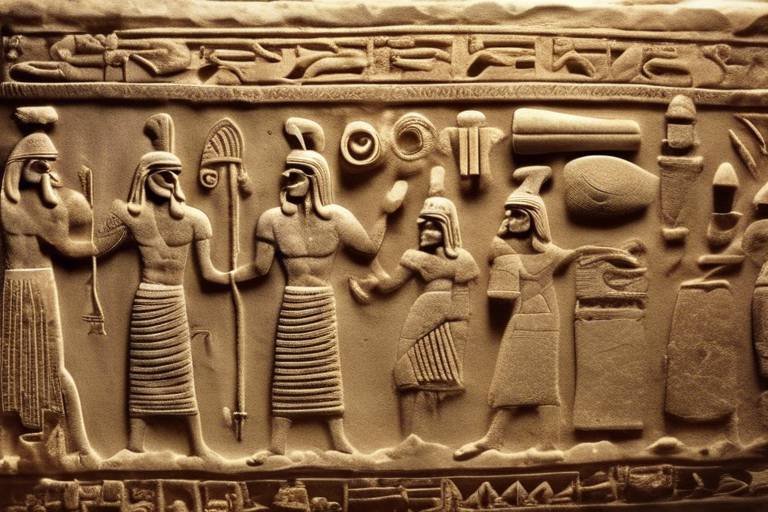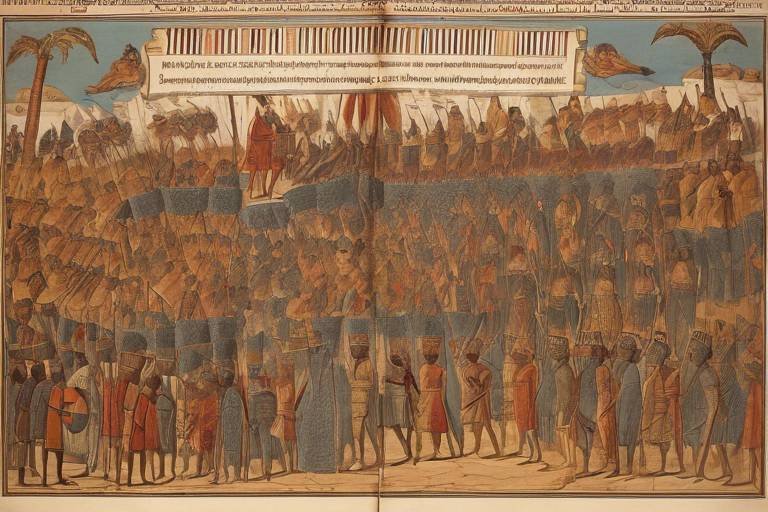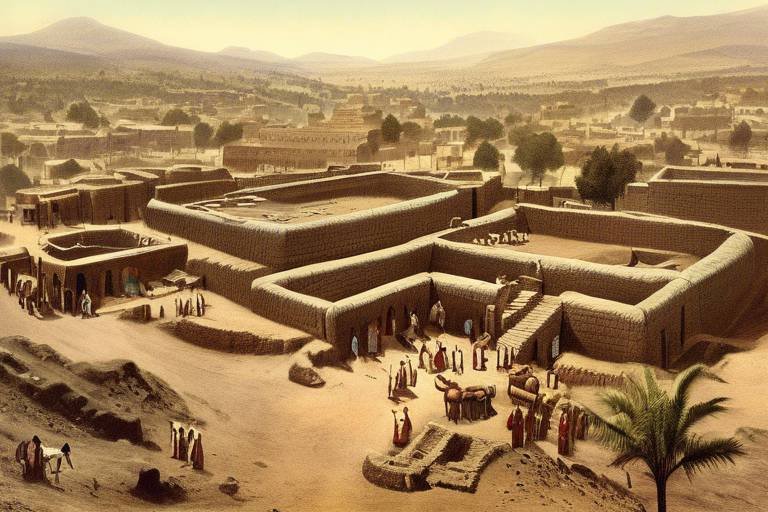Understanding the Decline of the Assyrian Empire
The fall of the once-mighty Assyrian Empire is a complex historical event that has puzzled historians for centuries. This ancient empire, known for its military prowess and vast territorial holdings, faced a series of challenges that ultimately led to its downfall. From economic struggles to internal rebellions and external pressures, the decline of the Assyrian Empire was a culmination of various factors that weakened its foundations.
One of the key factors contributing to the decline of the Assyrian Empire was the economic challenges it faced. Financial strain and mismanagement of resources put a significant strain on the empire's economy, impacting its ability to sustain military campaigns and invest in infrastructure development. As a result, the empire struggled to support its expansive military and administrative apparatus, leading to internal instability.
Internal dissent and uprisings from subjected peoples also played a crucial role in the empire's decline. The Babylonians, Medes, and other subjugated populations rebelled against Assyrian rule, draining resources and manpower in suppressing revolts. These internal conflicts further weakened the empire's grip on its territories and eroded its authority over its subjects.
Military overextension was another critical issue that plagued the Assyrian Empire. The constant expansion of its borders stretched the empire's military forces thin, making it difficult to defend its vast territories from external threats. This overextension left the empire vulnerable to attacks from rival powers and internal uprisings, further destabilizing its rule.
Political instability, exacerbated by the assassination of several kings, including Sennacherib and Ashurbanipal, also contributed to the empire's decline. The power struggles within the ruling elite weakened the leadership of the empire and created divisions that were exploited by external adversaries and rebellious factions.
Environmental factors such as droughts, famines, and other challenges in the region added to the empire's woes. These environmental pressures affected agricultural productivity, leading to food shortages and economic hardships for the Assyrian population. The inability to effectively address these environmental challenges further weakened the empire's stability and resilience.
As new regional powers like the Babylonians, Medes, and Persians rose to challenge Assyrian dominance, conflicts erupted that further weakened the empire. The loss of support from subject peoples, due to harsh Assyrian policies and brutal suppression of revolts, alienated populations that eventually turned against the empire, hastening its decline.
Moreover, the decline in military innovations and strategic effectiveness left the Assyrians vulnerable to more advanced adversaries. Once renowned for their military prowess and innovations, the Assyrians struggled to keep up with evolving military tactics and technologies, further weakening their position in the ancient Near East.
Despite its eventual collapse, the legacy of the Assyrian Empire continues to influence the history of the region, shaping future empires and civilizations. The rise and fall of this once-great empire serve as a cautionary tale of the perils of overextension, internal strife, and external pressures that can bring even the most powerful empires to their knees.

Economic Challenges
The economic challenges faced by the Assyrian Empire played a crucial role in its decline. The empire's once prosperous economy suffered from financial strain and mismanagement of resources, leading to a gradual weakening of its economic foundation. This, in turn, had significant repercussions on the empire's ability to sustain its military campaigns and invest in infrastructure development. The Assyrians, known for their wealth and trade networks, struggled to maintain their economic prosperity amidst growing internal and external pressures.

Rebellion and Revolts
Rebellion and revolts within the Assyrian Empire were not uncommon occurrences, as subjected peoples often rose up against their oppressors in a bid for freedom and autonomy. The Babylonians, Medes, and other groups under Assyrian rule frequently rebelled, challenging the authority of the empire and draining its resources in prolonged conflicts. These uprisings were fueled by grievances over harsh Assyrian policies, including forced deportations and brutal suppression of dissent.
One of the most notable revolts against the Assyrian Empire was the Babylonian uprising led by Nabopolassar, which eventually led to the fall of Nineveh, the Assyrian capital. The Babylonians, with the support of the Medes, managed to overthrow Assyrian rule and establish their own independent kingdom, marking the end of Assyrian dominance in the region.
The rebellion and revolts faced by the Assyrian Empire not only weakened its control over its vast territories but also sowed seeds of discontent among other subject peoples. The constant need to suppress revolts diverted resources and manpower away from other crucial aspects of governance, further contributing to the empire's decline.

Military Overextension
The of the Assyrian Empire played a crucial role in its eventual downfall. The empire's relentless pursuit of expansion led to stretching its military forces thin across vast territories, making it challenging to defend effectively against external threats. Imagine a rubber band being pulled to its limit; at some point, it is bound to snap under the pressure. Similarly, the Assyrian military found itself overextended, unable to maintain control over its extensive empire.
With each conquest, the Assyrians pushed their boundaries further, conquering new lands and subjugating diverse populations. However, this constant state of warfare and conquest drained the empire's resources and manpower, making it increasingly difficult to sustain such a massive military presence. The Assyrian army, once feared and formidable, began to show signs of strain and fatigue as it struggled to maintain control over rebellious territories.
Moreover, the logistical challenges of managing such a vast empire with limited communication and transportation infrastructure added to the burden of military overextension. Supply lines stretched thin, making it hard to provide provisions and reinforcements to distant outposts and garrisons. As a result, the Assyrian military found itself vulnerable to coordinated attacks from both internal rebellions and external enemies.
The overextension of the Assyrian military also had profound implications for the empire's internal stability. With a significant portion of its forces deployed in far-flung regions, the central government faced difficulties in maintaining control over its provinces. Local uprisings and revolts found fertile ground in areas where the Assyrian presence was weak or overstretched, further undermining the empire's authority.
In essence, the military overextension of the Assyrian Empire was akin to a giant tree with branches reaching in all directions but lacking a strong and stable trunk to support its growth. As the empire spread itself thin, it became increasingly vulnerable to internal dissent, external threats, and the erosion of its once-unshakable power. The lessons learned from the Assyrian experience serve as a cautionary tale about the perils of overextending military resources without a solid foundation to sustain such ambitions.

Assassination of Kings
The played a crucial role in the destabilization of the once-mighty Assyrian Empire. The empire faced internal turmoil and political unrest due to the targeted killings of several rulers, including prominent figures like Sennacherib and Ashurbanipal. These assassinations not only created power vacuums within the leadership but also sowed seeds of distrust and fear among the ruling elite.
The Assyrian Empire witnessed a series of assassinations that shook the foundation of its governance. The murder of King Sennacherib in 681 BC by his own sons reflected the intense power struggles within the royal family. Subsequent assassinations of rulers like Ashur-etil-ilani and Sin-shar-ishkun further exacerbated the political chaos, weakening the empire's ability to maintain stability and control.
The assassinations of Assyrian kings not only destabilized the political landscape but also had profound implications for the empire's military and administrative structures. The loss of experienced leaders due to targeted killings left the Assyrian Empire vulnerable to external threats and internal rebellions, as the new rulers struggled to assert their authority and maintain cohesion among the ruling class.
The not only led to immediate power struggles and internal conflicts but also contributed to the overall decline of the Assyrian Empire. The lack of strong and stable leadership undermined the empire's ability to effectively govern its vast territories and address the growing challenges posed by external adversaries and rebellious subject peoples.
As the Assyrian Empire grappled with the aftermath of successive assassinations, the once-mighty civilization found itself on the brink of collapse. The vacuum created by the targeted killings of kings left a void that could not be easily filled, hastening the empire's decline and eventual fall at the hands of rival powers and internal dissent.

Environmental Factors
Environmental factors played a significant role in the decline of the Assyrian Empire. The region faced challenges such as droughts and famines, which directly impacted agricultural productivity. The lack of sufficient rainfall led to crop failures, resulting in food shortages and economic hardships for the Assyrian population. With agriculture being a crucial aspect of the empire's economy, these environmental factors severely strained the empire's ability to sustain itself.
Moreover, the environmental challenges also affected the availability of resources needed for military campaigns and infrastructure development. The Assyrian Empire heavily relied on its agricultural output to feed its people and support its military endeavors. When faced with droughts and famines, the empire struggled to maintain its military strength and expand its territories, further exacerbating its vulnerabilities.
Additionally, the environmental factors contributed to social unrest within the empire. Food shortages and economic hardships fueled discontent among the populace, leading to increased internal dissent and uprisings. The inability of the empire to effectively address these environmental challenges weakened its control over its subjects and eroded the loyalty of the population.

Competition from Rival Powers
The fall of the once-mighty Assyrian Empire is a complex historical event. Various factors contributed to its decline, leading to the eventual collapse of one of the most powerful empires in ancient Mesopotamia.
Financial strain and mismanagement of resources weakened the economic foundation of the Assyrian Empire, impacting its ability to sustain military campaigns and infrastructure development.
Internal dissent and uprisings from subjected peoples, including Babylonians and Medes, posed significant challenges to the Assyrian rule, draining resources and manpower in suppressing revolts.
The constant expansion of the Assyrian Empire stretched its military forces thin, leading to overextension and difficulties in defending its vast territories from external threats.
Political instability and the assassination of several kings, including Sennacherib and Ashurbanipal, weakened the leadership of the empire and created power struggles within the ruling elite.
Droughts, famines, and other environmental challenges in the region affected agricultural productivity, leading to food shortages and economic hardships for the Assyrian population.
The rise of new regional powers such as the Babylonians, Medes, and Persians challenged the dominance of the Assyrian Empire, leading to conflicts that further weakened its position.
Harsh Assyrian policies, including forced deportations and brutal suppression of revolts, alienated subject peoples who eventually turned against the empire, further eroding its control.
The Assyrians, known for their military prowess and innovations, saw a decline in technological advancements and strategic effectiveness, making them vulnerable to more sophisticated adversaries.
Despite its decline, the Assyrian Empire's legacy continues to influence the history of the region, shaping future empires and civilizations in the ancient Near East.

Loss of Support from Subject Peoples
The fall of the once-mighty Assyrian Empire is a complex historical event. Various factors contributed to its decline, leading to the eventual collapse of one of the most powerful empires in ancient Mesopotamia.
Financial strain and mismanagement of resources weakened the economic foundation of the Assyrian Empire, impacting its ability to sustain military campaigns and infrastructure development.
Internal dissent and uprisings from subjected peoples, including Babylonians and Medes, posed significant challenges to the Assyrian rule, draining resources and manpower in suppressing revolts.
The constant expansion of the Assyrian Empire stretched its military forces thin, leading to overextension and difficulties in defending its vast territories from external threats.
Political instability and the assassination of several kings, including Sennacherib and Ashurbanipal, weakened the leadership of the empire and created power struggles within the ruling elite.
Droughts, famines, and other environmental challenges in the region affected agricultural productivity, leading to food shortages and economic hardships for the Assyrian population.
The rise of new regional powers such as the Babylonians, Medes, and Persians challenged the dominance of the Assyrian Empire, leading to conflicts that further weakened its position.
Harsh Assyrian policies, including forced deportations and brutal suppression of revolts, alienated subject peoples who eventually turned against the empire, further eroding its control.
The Assyrians, known for their military prowess and innovations, saw a decline in technological advancements and strategic effectiveness, making them vulnerable to more sophisticated adversaries.
Despite its decline, the Assyrian Empire's legacy continues to influence the history of the region, shaping future empires and civilizations in the ancient Near East.
Q: What was the significance of the Assyrian Empire in ancient Mesopotamia?
A: The Assyrian Empire was one of the most powerful empires in the region, known for its military strength and strategic innovations.
Q: How did economic challenges contribute to the decline of the Assyrian Empire?
A: Financial strain and mismanagement of resources weakened the empire's ability to sustain its military campaigns and infrastructure development.
Q: What role did rebellion and revolts play in the downfall of the Assyrian Empire?
A: Internal dissent and uprisings from subjected peoples drained the empire's resources and manpower, posing significant challenges to its rule.
Q: How did the competition from rival powers impact the Assyrian Empire?
A: The rise of new regional powers challenged the dominance of the Assyrian Empire, leading to conflicts that further weakened its position.
Q: What is the lasting legacy of the Assyrian Empire?
A: Despite its decline, the Assyrian Empire's legacy continues to shape the history of the ancient Near East, influencing future empires and civilizations in the region.

Decline in Military Innovations
The Assyrians, renowned for their military prowess and innovative strategies, faced a significant setback with the decline in military innovations. Once at the forefront of military technology and tactics, the Assyrian Empire began to lag behind more advanced adversaries. The lack of technological advancements and strategic effectiveness left them vulnerable to the evolving methods of warfare employed by rival powers.
Previously, the Assyrians had been pioneers in siege warfare, utilizing advanced siege engines and tactics to conquer fortified cities. However, as their empire started to decline, the pace of innovation slowed, and they struggled to keep up with the changing dynamics of warfare. This stagnation in military advancements weakened their ability to effectively defend their territories and expand their influence.
Moreover, the Assyrians' reliance on traditional methods and reluctance to adapt to new military technologies put them at a disadvantage against enemies who embraced innovation. The introduction of new weapons, tactics, and strategies by rival powers further marginalized the Assyrian military, diminishing their once dominant position in the region.
As a result, the decline in military innovations not only undermined the Assyrian Empire's military capabilities but also exposed its vulnerabilities to external threats. The inability to match the advancements of their adversaries ultimately contributed to the weakening of the empire and played a significant role in its eventual downfall.

Legacy and Impact
The legacy of the Assyrian Empire continues to reverberate through the annals of history, leaving a lasting impact on the ancient world. Despite its eventual decline and fall, the empire's influence can still be felt in various aspects of culture, politics, and warfare.
One of the most significant legacies of the Assyrian Empire is its military innovations and strategies. The Assyrians were renowned for their formidable army and advanced military tactics, which set the standard for future empires and civilizations. Their use of iron weaponry, siege engines, and organized military campaigns influenced military doctrines for centuries to come.
Furthermore, the Assyrian Empire's administrative practices and infrastructure developments left a lasting impact on governance and urban planning. The establishment of efficient bureaucratic systems, road networks, and monumental architecture set a precedent for future empires in managing vast territories and populations.
In the realm of art and culture, the Assyrians made significant contributions through their intricate relief sculptures, palace decorations, and literary works. These artistic achievements not only reflected the grandeur of the empire but also influenced the artistic traditions of succeeding civilizations in the Near East.
Moreover, the Assyrian Empire's interactions with neighboring cultures and peoples, despite their often brutal methods of conquest, facilitated the exchange of ideas, technologies, and cultural practices. This cultural diffusion played a crucial role in shaping the diverse tapestry of the ancient Near East and laid the foundation for future cross-cultural interactions.
While the decline of the Assyrian Empire marked the end of an era, its legacy endured through the rise of subsequent powers such as the Babylonians, Persians, and Greeks, who drew upon Assyrian achievements and experiences in shaping their own empires. The echoes of Assyrian influence can be traced throughout the pages of history, underscoring the enduring impact of this once-mighty civilization.
Frequently Asked Questions
- What were the main reasons for the decline of the Assyrian Empire?
The decline of the Assyrian Empire was primarily caused by economic challenges, internal rebellions, military overextension, political instability, environmental factors, competition from rival powers, loss of support from subject peoples, and a decline in military innovations.
- How did economic challenges contribute to the fall of the Assyrian Empire?
Financial strain and mismanagement of resources weakened the economic foundation of the empire, impacting its ability to sustain military campaigns and infrastructure development, ultimately leading to its decline.
- What role did rebellion and revolts play in the downfall of the Assyrian Empire?
Internal dissent and uprisings from subjected peoples drained the empire's resources and manpower in suppressing revolts, contributing to the weakening of Assyrian rule and eventual collapse.
- How did environmental factors affect the Assyrian Empire?
Droughts, famines, and other environmental challenges in the region affected agricultural productivity, leading to food shortages and economic hardships for the Assyrian population, further destabilizing the empire.
- What was the legacy of the Assyrian Empire despite its decline?
Despite its fall, the Assyrian Empire's legacy continued to influence the history of the region, shaping future empires and civilizations in the ancient Near East, leaving a lasting impact on the region.


















